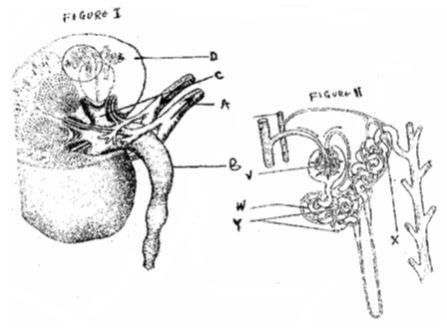INSTRUCTIONS TO CANDIDATES:
- You are provided with food substance labeled solution G. The reagent provided are Iodine solution, Benedicts solution, 2MHCl acid, 10% Sodium hydroxide solution Copper (II) sulphate and 10-% Sodium hydroxide solution.
- Perform food tests and fill in the table below. (12 mks)
Food substance Procedure Observation Conclusion -
- Name the enzyme responsible for digestion of food substance present in G in two named regions of the human alimentary canal. (2 mks)
- Name three deficiency diseases in children that may result from lack of one of the food substances in G. (1 mk)
- Perform food tests and fill in the table below. (12 mks)
- Study the kidney diagrams below.
- Name the parts labeled A, B, C and D in figure 1. (4 marks)
- Name the processes that take place in the parts labeled. V and W (2 marks)
- State two adaptations of the part labeled W. (2 marks)
- On the diagram name the part where counter current flow occurs. (1 mark)
- State two homeostatic functions of the diagram above. (2 marks)
- Explain what will happen to the process of urine formation in absence of vasopressin hormone.(4 marks)
- The photographs on the leaf attached are of animals belonging to the same taxonomic unit (class).
- Name the class to which the organisms in the photographs belong. (1mk)
- State three reasons for your answer in a) (i) above. (3mks)
- State three economic importance of organisms in this class. (3mks)
- Use the following characteristics to prepare a two step dichotomous key of the animals in the photographs. (4mks)
MARKING SCHEME
- You are provided with food substance labeled solution G. The reagent provided are Iodine solution, Benedicts solution, 2M HCl acid, 10% Sodium hydroxide solution Copper (II) sulphate and 10-% Sodium hydroxide solution.
- Perform food tests and fill in the table below. (12 mks)
Food substance Procedure Observation Conclusion Starch To absorb 2cm3 of G,
add a few drops of
iodine solutionNo color change/brown
color of iodine remainsStarch absent Reducing sugar To about 2c3 of
solution G, add 2cm3
of benedicts solution
and heat (to boil)No colour change blue
colour remainsReducing sugar absent Non-Reducing sugar To about 2cm3 of
solution G add 1cm3 if
2m HCl and boil. Cool
and NaHCO3 dropwise
until fizzing stops add
1cm3 of Benedicts
solution and heatColour changes to
orange/orange
precipitate formedNo reducing surgar
presentProteins To about 2cm3 of
solution G, add 5 drops
of 10% NaOH and
shake. Then add 0.5%
of copper (II) sulplhate
solution drop by dropl
while shaking.Mixture turns purple Protein present -
- Name the enzyme responsible for digestion of food substance present in G in two named regions of the human alimentary canal. (2mks)
- In the stomach – enzyme pepsin
- In the duodenum – enzyme trypsin
- Name three deficiency diseases in children that may result from lack of one of the food substances in G. (1 mk)
- Kwashiorkor
- Name the enzyme responsible for digestion of food substance present in G in two named regions of the human alimentary canal. (2mks)
- Perform food tests and fill in the table below. (12 mks)
-
- A – Renal vein. B – Ureter. C – Kidney pelvis. D – Cortex.
- Has numerous mitochondria to provide energy for active transport. - Has microvilli in the inner lining to increase surface area for reabsorption of substances. - Highly vascularised for transport of reabsorbed substances. - Has a thin epithelium for rapid diffusion of substances.
- On the diagram to show loop of henle.
- Osmoregulation. - Regulation of pH.
- The distal convoluted tubules and collecting duct will be less permeable to water; therefore less reabsorption of water, leading to production of large volume of urine; that is dilute
-
- Class insecta; rej insects
- Presence of one pair of antennae
Three body parts; head, thorax and abdomen; rej. if parts are not named
Three pairs of walking legs;
One pair of compound eyes; (Acc. any three) b) Some are pollinators
Some can be used as food e.g. termites - Some produce edible substances e.g. honey
Some destroy buildings
Some are disease vectors
Some acts as pests and parasites Any 3 max 3mks
- Insects with wings ............................. go 2;
- Insects without wings ............................. Termite/ant;
- With proboscis..................................... Butterfly
- With mandibles ................................. Cockroach
Join our whatsapp group for latest updates
Tap Here to Download for 50/-
Get on WhatsApp for 50/-
Download BIOLOGY PAPER 3 Questions and Answers - Form 3 End Term 1 Exams 2023.
Tap Here to Download for 50/-
Get on WhatsApp for 50/-
Why download?
- ✔ To read offline at any time.
- ✔ To Print at your convenience
- ✔ Share Easily with Friends / Students



